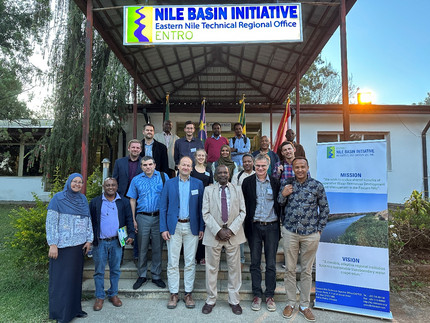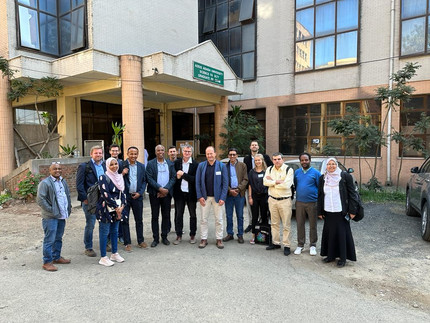Predict the water resources of the Blue Nile
Kick-off workshop for the research project „SPS-Blue Nile“ in Addis Abeba, Ethiopia
In the week of November 13-17, 2023, an intensive scientific exchange took place in Addis Ababa, Ethiopia, regarding the project 'Development and Practical Implementation of a Seamless Prediction System (SPS) to Support Transboundary Water Management of the Blue Nile.' From the University of Potsdam, Prof. Axel Bronstert and Dr. Morteza Zargar participated. In this project, the Chair of Hydrology and Climatology at the University of Potsdam is leading in matters related to water availability, soil erosion, and sediment transport.
The Nile and its tributaries are the primary water source for 400 million people in eleven riparian states. The largest tributary, contributing approximately 60 percent of the total flow and 75 percent of the sediments, is the Blue Nile in Ethiopia and Sudan. Existential questions for the population in this region include:
- How much water will the Blue Nile bring to these regions in the future?
- How can irrigated agriculture and water reservoirs, especially the new 'Grand Ethiopian Renaissance Dam,' be better managed there?
- How much sediment is mobilized by rainfall today and in the future, transported in the river system, and deposited in lakes and reservoirs?
German, Sudanese, and Ethiopian participants are developing a meteorological-hydrological forecasting system for transboundary water management of the Blue Nile in the collaborative project 'SPS-Blue Nile,' funded by the German Federal Ministry of Education and Research (BMBF). The goal is a 'seamless' approach with interconnected forecasting horizons ranging from days to several months. This aims to enable a comprehensive, transboundary assessment and derivation of recommendations for the interrelated sectors of water, food, and energy.
Due to the immense significance of the Blue Nile, it is crucial that the new 'Grand Ethiopian Renaissance Dam' (GERD), Africa's largest dam and hydroelectric power plant, is operated in coordination with the downstream countries Sudan and Egypt. Particularly during prolonged droughts, concerted, transboundary, and sustainable water management is necessary to ensure downstream electricity generation, water supply, and irrigation. Tensions related to the dam are partly exacerbated by issues with the shared data foundation.
The project involves close collaboration with local partners from Ethiopia and Sudan. Regular workshops and training courses, both online and in the target region, along with joint doctoral programs, aim to develop the SPS system collaboratively. Researchers share their methods and information, conducting joint research activities. The close connection to politics and water management by participants in both countries is intended to facilitate the transfer of the work into practice, ensuring a sustainable application of the developed methods beyond the project's duration.



